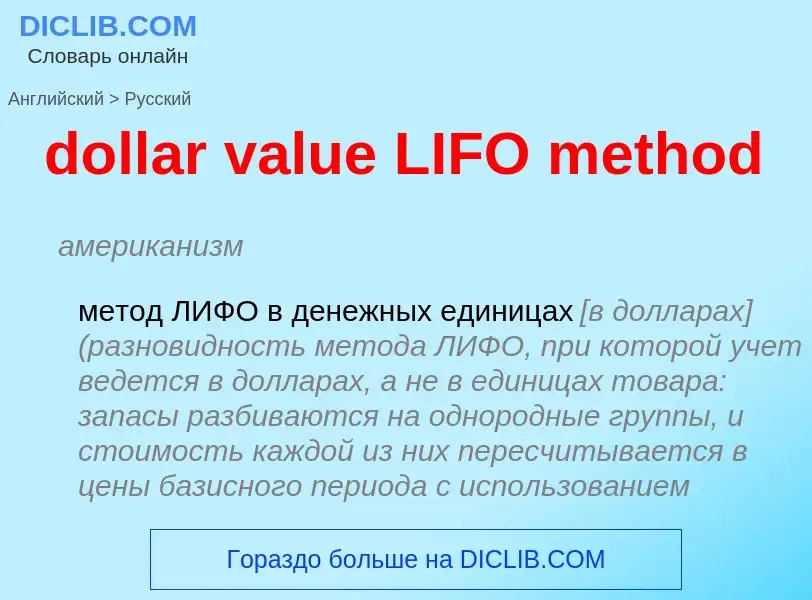Translation and analysis of words by ChatGPT artificial intelligence
On this page you can get a detailed analysis of a word or phrase, produced by the best artificial intelligence technology to date:
- how the word is used
- frequency of use
- it is used more often in oral or written speech
- word translation options
- usage examples (several phrases with translation)
- etymology
dollar value LIFO method - translation to English
американизм
метод ЛИФО в денежных единицах [в долларах] (разновидность метода ЛИФО, при которой учет ведется в долларах, а не в единицах товара: запасы разбиваются на однородные группы, и стоимость каждой из них пересчитывается в цены базисного периода с использованием соответствующих индексов цен, разница между индексированными остатками запасов на начало и конец периода используется как показатель изменения запасов за период и прибавляется к остатку на начало года)
синоним
[pi:səv'eit]
история
песо (испанская монета, равная восьми реалам)
Wikipedia

Value averaging (VA), also known as dollar value averaging (DVA), is a technique for adding to an investment portfolio that is controversially claimed to provide a greater return than other methods such as dollar cost averaging. With the method, investors add to (or withdraw from) their portfolios in such a way that the portfolio balance reaches a predetermined monthly or quarterly target, regardless of market fluctuations. For example, an investor may want to have a $3600 investment in 36 months. Using VA, the investor would aim to have a total investment value of $100 at the beginning of the first month, $200 at the beginning of the second month, and so on. Having invested $100 at the beginning of the first month, the investment may be worth $101 at the end of that month. In that case, the investor invests a further $99 to reach the second month objective of $200. If at the end of the first month, the investment is worth $205, the investor withdraws $5.
The idea of VA is that in periods of market decline, the investor contributes more, while in periods of market climb, the investor contributes less. As illustrated in the above example, in contrast to dollar cost averaging, which mandates that a fixed amount of money be invested at each period, the value averaging investor may on occasion be required to withdraw from the portfolio to keep to the program. Value averaging was developed by former Harvard University professor Michael E. Edleson.
The investor must provide the expected rate of return to the value averaging formula. The inclusion of this piece of information is claimed to allow the value averaging formula to identify periods of investment over-performance and under-performance versus expectations. If the investment grows faster than expected, the investor will be required to buy less or sell. If the investment grows slower than expected or shrinks, the investor will be required to buy more.
Some research suggests that the method results in higher returns at a similar risk, especially for high market variability and long time horizons. Other research suggests that VA offers no benefit at all in dollar terms, claiming that the rate-of-return benefit of VA is illusory because it is mathematically biased, retrospectively giving more weight to past returns if they were strong and less weight if they were weak.






